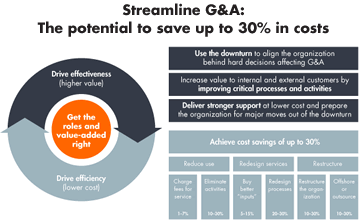Harvard Business Review
When cost reduction becomes an urgent priority, one of the first places executives look for savings is general and administrative (G&A) expenses—the cost centers that provide support and back-office functions such as finance, information technology and human resources.
The natural temptation is to get it over quickly with across-the-board cuts. There's no doubt that this will eliminate some unnecessary expense-and in a hurry. But it often destroys value in the process. Indeed, managers can unwittingly eliminate activities essential to driving sales and profits.
There's a better approach. It's almost as quick as slashing away, and in our experience it produces cost savings that are sustainable, typically in the range of 10 to 30 percent. It also improves the productivity and effectiveness of support functions, which in turn helps boost the performance of a company's front line—a powerful advantage in a downturn.
It starts with upending standard thinking about G&A. We call this "inverting the pyramid." The usual organizational pyramid shows front-line managers and employees—the people engaged in the primary profit-making activities of the business, whether it's serving customers or producing semiconductors—at the base. Support functions are in the middle, with senior management on top. Rotating the pyramid emphasizes the importance of those who actually provide the products and services that customers value. Everything is balanced on their performance.
This perspective sharpens management's focus on honing support services. Questions become: Which of HR's many roles help put talented, well-trained people in a company's critical positions? Which of IT's activities solve problems that are getting in the way of delivering value to the customer?
We've discovered three main ways that leading companies maximize front-line services while eliminating unnecessary G&A expense: reduce, redesign and restructure.
To Reduce, companies clarify what support functions are expected to deliver and eliminate nonessential activities. Some companies use internal pricing mechanisms to see which services front line managers really want, based on what they're willing to pay for.
Redesign requires companies to scrutinize the processes that deliver support services. They can streamline some—often by automating certain steps—and purchase better or lower-cost inputs for others.
Restructuring usually involves consolidation or outsourcing. The goal is to ensure that support services are located and organized in such a way that they can perform most effectively at lowest cost.
View the larger version of this chart
One company that employed these "three Rs" was Kyobo Life, a Korean financial services company. Kyobo discovered that its typical branch sales agents spent 60 percent of their time on support—a back-office function—and only 40 percent on selling. Kyobo actually invested in more G&A infrastructure-in this case a call center—which energized its salesforce.
Read the full article for more details about how Kyobo and other global companies have balanced G&A efficiency and effectiveness.
Hernan Saenz is a partner in Bain & Company's Dallas office and a leader in the firm's North American Performance Improvement practice. Darrell Rigby is a Bain partner in Boston and leads the firm's Global Retail practice.
